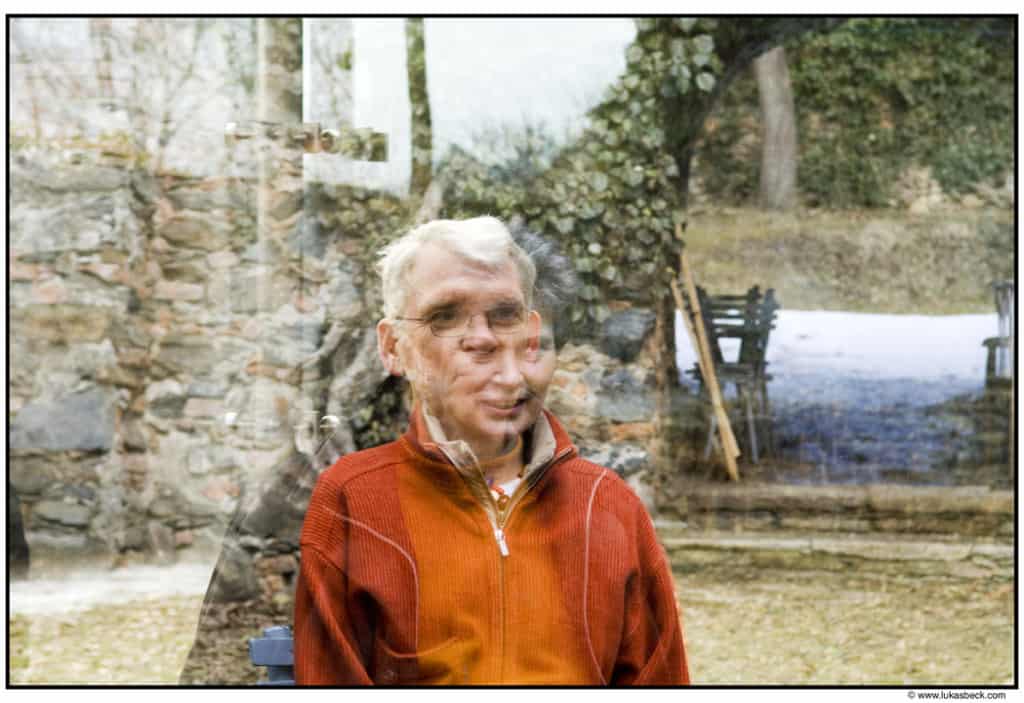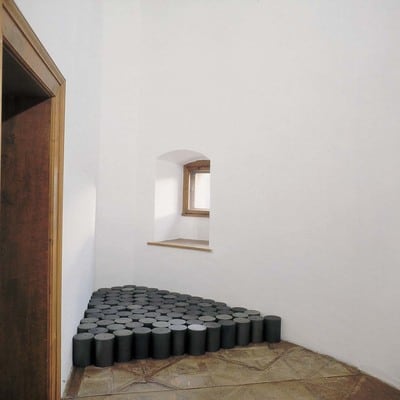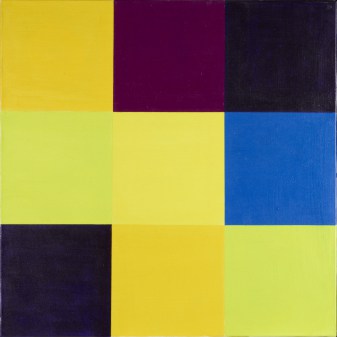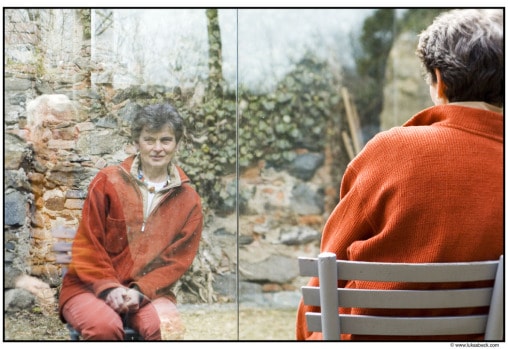Museum planners: Gertraud and Dieter Bogner began collecting art about thirty years at the castle “Schloss Buchberg” located in Gars am Kamp in Lower Austria. After donating about 400 pieces, a large part of their collection, to the Mumok they still continue to collect.

Dieter and Gertraud Bogner, Pavilion „Star of David“ by Dan Graham, 198996; photos Lukas Beck
Viennacontemporary: Let’s start from the beginning. Did you grow up around art and did your parents influence your collecting or is the origin somewhere else?
Dieter Bogner: Not at all, I was working in the industry in the 60ies before I studied art history with a focus on medieval painting and sculpture in France.
Gertraud Bogner: I studied physiotherapy and later moved on to cultural and social anthropology.
Dieter: In the 70s I studied art history and archaeology. It was later on when we began to work with contemporary art. In the 80ies I organized exhibitions, in the 90ies I developed the MuseumsQuartier, the largest cultural project in Vienna and in the 90ies we started our own company for curatorial and museological concepts.
VC: Did you purchase art right from the get-go?
Gertraud: Our engagement in contemporary art began in the 70ies when we lived in Paris. There we met an Austrian artist, Hildegard Joos, who made us sensible for contemporary art. She created geometrical paintings.
Dieter: Since then, we concentrate on geometrical, constructive and conceptual art, which was not very popular in Austria at that time. We organized an international symposium and workshop on constructive art at the castle in ’79, with Richard Paul Lohse lecturing and young artists producing artworks. This was an important experience for us.
VC: And that’s when you started to think about a collection?
Gertraud: The castle was empty! The rooms where ideal to show art and we exchanged artworks with the artists working in Buchberg. This was the beginning of the collection. Some years later, Dora Maurer, a Hungarian artist, proposed to paint a room in the 12th-century tower. With this artwork she initiated what we call today Kunstraum Buchberg: a collection of 25 permanent, site-specific installations inside and outside the castle. The last one, Dort Margreiter’s “cinema”, was finished last year. These site-specific installations, which cannot be transferred, and the “movable” collections are linked in many ways.

Castle Buchberg, photos: www.bogner-cc.at

Castle Buchberg, photos: www.bogner-cc.at

Castle Buchberg, photos: www.bogner-cc.at
VC: You said few people were interested in the art you were focussing on in the 70s and 80s – what triggered your interest?
Dieter: There was and still is today a close relation between the development of the collection and my scientific research on structural and analytic concepts in Austrian culture of the early 20th century. Neopositivism, Ludwig von Wittgenstein, Otto Neurath, Robert Musil, Adolf Loos, Josef Hoffmann, Frederic Kiesler, Josef Matthias Hauer, Viennese Kineticism as well as new methods in art history, etc. had and still have on an international level a strong impact on 20th-century culture. To understand the importance of this wide range of intellectual thoughts and artistic productions, and its influence on Austrian Art after WW II, a holistic transdisciplinary view is necessary. An integral part of the collection is the archive and the library. We buy rare artistic and methodological publications but also archives with the intention to combine artworks with their historical context.
Gertraud: When in the early 80ies content-loaded expressive paintings dominated the art world, we fought as a minority for constructive art. But only a few years later Neo Geometry and Neo Concepts came up and since the middle of the 80ies they play an important role. Our collection followed these new tendencies, often reflecting formalism and constructivism of the early 20th century.
VC: What do you think the role of a collector is? They are indeed a very important part of the art scene. But I rarely see private collectors who are thinking the way institutions do: to build a line and fill up the gaps with archive material and so on… Do you have a feeling of a certain mission?
Dieter: When we donated a huge part of our collection to the mumok in Vienna, we were able to fill a gap in the museum’s collection. Our mission was to bring to the public what we felt should be part of the contemporary art discussion. In this regard the museum’s policy failed. Therefore the mumok was happy to get this material.

Roland Goeschl, Raum-Eck-Komposition, 1984

Monika Brandmeier, sehr sehr, 1988
VC: Was it easy for you to let go of part of your collection and give it to the museum?
Dieter & Gertraud: No
VC: What was the decisive factor for you?
Gertraud: It was an interesting experiment for us to give away the collection without any conditions and watch from a distance how the museum would deal with it. From our point, the first ten years were extremely positive. We saw our collection’s pieces in very different curatorial settings. Each time an exhibition from the museum’s collection opened we were curious to learn more about “our” pieces. We do not ask the museum to show part of our collection permanently. Such contracts with donors are disturbing the development of innovative curatorial concepts. It seems that this good climate will continue: Recently, the museum asked us to show a thematic selection of our collection on the main floor next November. It’s a challenge, because we have never had the possibility to see a part of the collection in one huge gallery space.
Dieter: After the donation we continued to collect. But we do it together with the museum. Most of the pieces we buy go directly into the museum collection. We are expanding our collection in the museum!
Gertraud: When we gave the collection to the museum we realized we’d have more possibilities and more energy to continue collecting if we do it together with the museum.
Dieter: Since the early 80ies, the mumok is very much related to our biography. We curated several shows, know the curators very well, support initiatives of the museum and of the concept for Museumsquarter Vienna. I was very involved in the development of the museum.
Dieter: We dislike temporary loans, which often are withdrawn and sold after ten or fifteen years. The pieces the museum was proud of are suddenly missing and a gap opens in the collection. Our philosophy is: either give it away or keep it!
Frantisek Lesák, Machtspiele, 1973, Video auf DVD, video transferred to DVD, s/w, sound, 11:36 min, collection Dieter und Gertraud Bogner im mumok, since 2007, © Frantisek Lesák, Photo: mumok

Richard Paul Lohse, Ordnung aus Gleichung und Kontrast, 1952–1982, collection Dieter and Gertraud Bogner in mumok, since 2007 © Bildrecht Wien, 2016, Photo: mumok

Heimo Zobernig, O.T., 1989, collection Dieter and Gertraud Bogner in mumok, since 2006, © Bildrecht Wien / Heimo Zobernig, 2016, Photo: mumok
VC: Talking about viewing the collection from the 80s now with different eyes – was there something that you now look back on and you regret buying, or something you regret not buying something? And do you think, ah, I should have done it, or I shouldn’t have?
Dieter: (Sigh) There is always something you could have bought in time, or before a museum or other collector took it. But there are always many artworks available which could fit into the collections. The barrier is the necessary budget.
VC: That’s a very interesting point to me, prices. I see a lot of young people perhaps interested in art, but hesitant because it’s not as accessible as it was before. At the same time I do believe that one does not really have to have a lot of money to collect. What is your approach to that? Is there a line where you say it’s too expensive – or do you buy no matter the price if you really want it?
Dieter: We canot buy in the category of high-priced artists. We rather focus on buying works from young, upcoming artists. We recently bought installations by the Croatian artist David Malkovic and the Ukrainian artist Nikita Kadan which the mumok proposed. We gave both installations to the museum − the question if their value would be much higher in a few years was of no importance.
Gertraud: It’s more important to learn and to know about contemporary art, to try to be in contact with the artists, to visit them in their atelier, in their workshops, and be together. Over time you develop a feeling for what you can buy with a small budget.
VC: Is it important for you to know the artists personally?
Dieter: It is not important to know an artist personally before you buy. But to experience the artist’s personal context and his thoughts is helpful to generate individual knowledge about the artworks you have in the collection.
VC: Has there ever been a situation where you really like the work, but not the artist’s personality?
Dieter: There is one artist, we have a lot of his works, he was a very difficult person, and many people didn’t like him. We were not friends but we had a good relationship. I knew that he could be very nasty but his work is incredibly important and the funny thing is, now that we have it, people have started to take notice because they realize: Wow, he did that in the 50ies?
VC: What does your decision-making-process look like when you buy a work?
Gertraud: I choose more personally and intuitively, Dieter more rational. This seems to me a good combination, it creates variety within the collection.
Dieter: Sometimes if I think that we should buy an artwork from an artist because his work would fit into our collection concept, I ask Gertraud to make the final decision, because intuition is important for a good choice.

Dieter and Gertraud Bogner, Pavilion „Star of David“ by Dan Graham, 1989/96; photos Lukas Beck

Dieter and Gertraud Bogner, Pavilion „Star of David“ by Dan Graham, 1989/96; photos Lukas Beck
VC: How many artworks are in your collection?
Gertraud: We gave the mumok about 100 paintings, sculptures, installations and 300 gouaches, rare books and archival materials.
Dieter: But there is still a lot of artworks hanging around in Buchberg and Vienna together with the permanent installations.
VC: How did you come across the projects of museum in progress?
Dieter: When Karola Kraus came to Vienna to head mumok, she put together an exhibition, “Museum der Wünsche”, where she showed artworks she would have liked people to buy for mumok.
Dieter: We were at the opening and upon scrolling through, I saw the archive of museum in progress. It was an immediate decision to buy it. As I said before: Archives are as important as artworks.
VC: What does collecting mean to you? There are curators, they don’t have to own works, they work with art, they curate… You curate as well – why do you have to own it?
Gertraud: For me it means a lot to handle artworks physically, to change them regularly, that means to live actively with them.
Dieter: My approach is very much conceptional related to my research. On the other hand I’m open for critical comments of young artists, helping to change the perspective, and to stay not always with the same generation but to go ahead. Dóra Maurer, Mona Brandmeier and Dorit Margreiter three artists who were important for us and of course Thomas Kaminsky, our long-term friend and adviser.
Gertraud: We are very relaxed when dealing with artworks we own. Sometimes we have the opportunity to exhibit them in a museum, some works are on display at the castle, where we call it private curating.
VC: Thank you very much Dieter and Gertraud for the insightful talk.
Written by viennacontemporary







